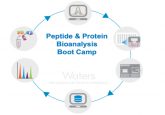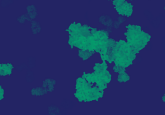Saved by the gel: spider silk hydrogels as therapeutic delivery agents

Spider silk has long been known for its incredible mechanical properties, with tensile strength outperforming that of steel. But research has now found a new use for spider’s silk—to produce transparent, self-supporting hydrogels. Researchers from Karolinska Institutet (KI) (Stockholm, Sweden) and the Swedish University of Agricultural Sciences (SLU) (Uppsala, Sweden) demonstrate the useful properties of hydrogels and its potential for creating new biomaterials.
All seven types of spider silk are made up of proteins called spidroins, which form a central repetitive region bookended by N- and C-terminal domains (NT and CT). In response to changes in conditions such as pH, temperature and sheer and extensional forces, spidroins can convert from an α-helix structure into β-sheets.
Researchers from KI and SLU have demonstrated that recombinant miniature spidroins, as well as NT by itself, go through this structural transition from α-helix to β-sheets, and form amyloid-like fibrils at 37°C. Consequently, the recombinant spidroins form self-supporting, transparent hydrogels, without being subjected to extreme conditions.
When forming hydrogels in vitro, proteins are usually exposed to organic solvents, high temperatures (70-90°C) and/or low pH (1.5-3.0) to unfold the proteins partially or fully. Here, no harsh treatment or cross-linking reagents were needed to form the hydrogel, revealing promising applications for use in vivo.
You may be interested in:
- Impact of Drug Delivery on Bioanalysis – workshop during Reid Bioanalytical Forum 2022
- The bioanalysis of lipid nanoparticle delivery systems
- Jiminy cricket! Locusts discovered to ‘smell’ cancer in humans
Advancing on this, the recombinant spidroins were fused to green fluorescent protein (GFP) and purine nucleoside phosphorylase (PNP). Despite the attachment of these additional proteins, gelation was still possible at 37°C and both GFP and PNP maintained their activity post-gelation, to a large extent. This is particularly significant for biopharmaceutical applications, as GFP and PNP are important markers and catalysts respectively.
Anna Rising, research group leader at KI and professor at SLU, commented:
“We have developed a completely new method for creating a three-dimensional gel from spider silk that can be designed to deliver different functional proteins.”
Fusion proteins that form transparent hydrogels under benign conditions can be used to make functionalized hydrogels with a wide range of applications, including immobilization of enzymes, controlling drug release and tissue engineering.
Tina Arndt, primary author of the paper, and PhD student in Anna Rising’s research group at Karolinska Institutet, noted:
“In the slightly longer term, I think injectable gels can become very useful in regenerative medicine. We have a long way to go, but the fact that the protein solution quickly forms a gel at body temperature and that the spider silk has been shown to be well tolerated by the body is promising.”
This study advances on previous work reporting on hydrogel formation, particularly through reduced incubation times and temperatures, as well as producing a transparent gel rather than previous opaque hydrogels. Additionally, at >300mg/ml, the mechanical properties of the NT hydrogels outperformed all other reported recombinant spidroin gels, as well as several natural hydrogels such as gelatin, alginate, agar and collagen.
Sources:
Arndt T, Jaudzems K, Shilkova O, et al. Spidroin N-terminal domain forms amyloid-like fibril based hydrogels and provides a protein immobilization platform. Nat. Commun. 13, doi: 10.1038/s41467-022-32093-7 (2022), Eureka Press Release, https://www.eurekalert.org/news-releases/961819






